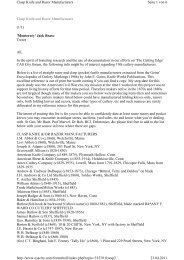razors, razor hones, razor strops and razor honing - antike ...
razors, razor hones, razor strops and razor honing - antike ...
razors, razor hones, razor strops and razor honing - antike ...
You also want an ePaper? Increase the reach of your titles
YUMPU automatically turns print PDFs into web optimized ePapers that Google loves.
19<br />
even. Resting the fingers of the left h<strong>and</strong> on the blade, as shown in cut 2, will<br />
steady the motion of the <strong>razor</strong> on the hone <strong>and</strong> help in obtaiuiug an even edge.<br />
Tenth. Rubbing the faces of the two <strong>hones</strong> together will keep them even <strong>and</strong><br />
make them adhere more keenly. Any <strong>hones</strong>, especially the oil <strong>hones</strong>, become too<br />
glossy (steel bound) when used a half dozen or more times without rubbing. Short<br />
rubbers are not so good as large <strong>hones</strong>. The former are apt to make the face of the<br />
hone uneven, while the latter will always keep it perfectly even. Long <strong>hones</strong> (eight<br />
or ten inches) are better than short ones to keep an even bevel on the <strong>razor</strong>, <strong>and</strong><br />
can be used more successfully in every way.<br />
Hones of less than five inches will cause<br />
much trouble with the <strong>razor</strong>.<br />
A Cure for "Tired" Razors.<br />
When a <strong>razor</strong> is tired (as some Barbers term it), or refuses to work, the trouble<br />
is either with you, with your hone, or with your strop, <strong>and</strong> not with the <strong>razor</strong>. Now<br />
to prove this assertion, I give the following cures : Try another hone if<br />
;<br />
you have<br />
been using a water hone, change to an oil hone <strong>and</strong> vice versa, or let another Barber<br />
hone it once or twice, or change your way of <strong>honing</strong>. If the edge is uneven,<br />
straighten it b} drawing T it across the hone a few times <strong>and</strong> hone down again to a<br />
new edge. Or, if worn to a thick, blunt or uneven edge, take it to a <strong>razor</strong> grinder<br />
<strong>and</strong> have a very light twenty-five cent grinding put on, just enough to straighten<br />
the edge, <strong>and</strong> you will find that it will cut allright. (An occasional twenty-five cent<br />
grinding, a light touching up, will help in keeping <strong><strong>razor</strong>s</strong> in good working<br />
order). The idea is to change the edge <strong>and</strong> the bevel which has been honed one way<br />
too many times, hence become one-sided, or uneven, or rough, or too smooth or<br />
rounded. Or it may be that your <strong>strops</strong> are filled with dust or grit <strong>and</strong> destroy the<br />
edge which you have produced by <strong>honing</strong>, or the <strong>strops</strong> may be too gloosy <strong>and</strong> have<br />
no effect on the <strong>razor</strong>. Some Barbers go on the theory that they must hone their<br />
<strong><strong>razor</strong>s</strong> a little rough in order to make the edge last, <strong>and</strong> they pull a few customers<br />
until the wire edge is worn off, then they think that they are prepared to do good<br />
work <strong>and</strong> call themselves workmen. Good Barbers hone their <strong><strong>razor</strong>s</strong> to cut smooth<br />
from the start.<br />
Every barber should possess from six to twelve <strong><strong>razor</strong>s</strong>. This will give them a<br />
"reserve" to fall back on in time of rush or busy days, but they should only keep<br />
two or three <strong><strong>razor</strong>s</strong> in constant use, as, when using too many <strong><strong>razor</strong>s</strong> on the same<br />
day, one will lose track of those needing <strong>honing</strong>, or hone before his <strong><strong>razor</strong>s</strong> are dull<br />
<strong>and</strong> get them out of working order by being overhoned. When those two or three<br />
<strong><strong>razor</strong>s</strong> become out of working order (refuses to work or are "tired") lay them aside<br />
<strong>and</strong> use another two or three, or see instruction on "tired" <strong><strong>razor</strong>s</strong>.<br />
Instructions on Razor Strops. How to Prepare<br />
them <strong>and</strong> How to Use them.<br />
Linen canvas makes one of the best first <strong>strops</strong> when properly prepared <strong>and</strong> well<br />
broken in. Barbers' Supply Dealers have them in both states, natural <strong>and</strong> partly<br />
broken in (the face ground). If in rough state, smooth (grind) on a grind-stone,<br />
beat the dust out ; then fill with cotton seed oil, let dry a few days. When the oil<br />
begins to get gummy tack it down tight on a smooth board (face up), use a heavy<br />
quart bottle to rub it down smooth, rubbing to <strong>and</strong> fro with the bottom at first, <strong>and</strong><br />
finish with the side of the bottle, bearing on it with both h<strong>and</strong>s. When smooth rub<br />
with lead pipe (or rub-stick for that purpose) until black. Then apply the bottle<br />
again until nearly smooth enough to use. Then rub in some shaving soap or thick<br />
lather to finish smoothing it.<br />
Cotton duck or canvas will also make good <strong>strops</strong> (but damp weather makes it<br />
stiff.) Prepare in same manner as linen canvas. There are several kinds of canvas<br />
or cloth <strong>strops</strong> which are about as good as the foregoing.<br />
Curtin's"Hose <strong>and</strong> Canvas Strop, prepared <strong>and</strong> finished (ready for use) by their






